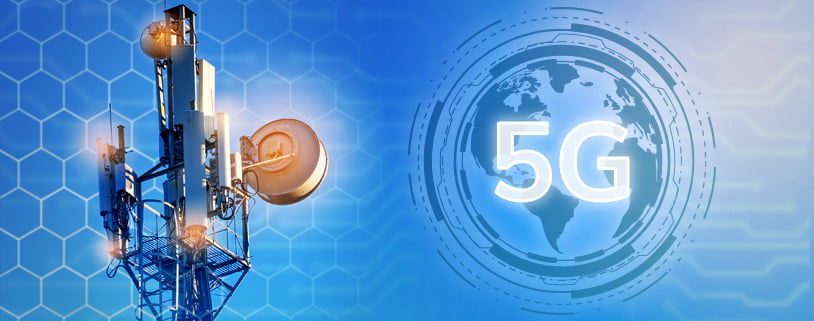1G (1st Generation)
1G was very first commercial telecommunication wireless technology and introduced in the 1980s. For the first time, Nippon Telegraph and Telephone (NTT) introduced it in Tokyo, Japan. From there, it got the attention of consumers and enjoyed a large market share. In 1981, 1G was introduced in some European countries and in 1983; 1G penetrated into US market.
Technology: 1G employed analogue radio signals for communication.
Speed: The speed of 1G was merely up to 2.4Kbps.
Functions: 1G could be used only for voice calls.
Flexibility: Prior to it, telephone required wired connections for communication. After this development, 1G was easy for people to take their phones outdoor.
Replacement: 1G successfully replaces 0G radio technologies, such as Mobile Telephone System (MTS), Advanced Mobile Telephone System (AMTS), and Push to Talk (PTT), dominant in those days.
Success: 1G technology used one universal network standard, called Advanced Mobile Phone System (AMPS), which is still prevalent today.
2G vs. 3G
2G (2nd Generation)
The development of the technology took a new turn and a new generation “2G” was introduced in 1991 in Finland. 2G was based on GSM standard. It was more advanced than its predecessor and almost made that obsolete.
What’s new: 2G technology allowed users to send and receive text messages and multimedia messages (MMS).
Technology: 2G used digital signals for communication with a radio tower.
Speed: The transfer speed of 2G Network increased many a time and reached theoretically maximum transfer rate of 50Kbps with the help of General Packet Radio Service (GPRS).
Battery power: 2G required low battery power due to low consumption of the battery by digital signals.
Quality: The quality of sound is improved and the user does not face any background noise.
Privacy: 2G improved the privacy of users as the messages and MMS were digitally encrypted and the only user can open them.
No more cloned handsets: In the days of 1G, it was possible to possess two handsets with the same number. But, 2G closed this chapter and ended any chance of fraudulent acts involving two numbers.
Disadvantages:
- Weak signal: If the signals are weak in any specific area, the users will not get network coverage in that area.
- Digital signal has an angular curve, which jagged decay curve, while analogue has a smooth one. When conditions go worse, the analogue signal will perform better than the digital one.
- The reduced tone of sound: It occurs on account of the use of lossy compression by the codes.
2.5G: It is interim technology between “2G and 3G”. To put it simply, it can be defined as 2G + GPRS. It was more efficient than its predecessors because it used a packet-switching technique beside circuit-switched domain. In fact, it increased the transfer rate of 2G technology. It also enabled users to browse the web on their mobile phones.
2.75G: 2.5G further evolved and resulted in 2.75G, also called (EDGE) Enhanced Data rates for GSM Evolution. It is faster than GPRS.
- Although 2G is still available in various countries, some countries have planned to shut it down.
3G vs. 4G
3G (3rd Generation)
3G is the next generation and provides better services in all aspects. 3G was introduced in 2001 and follows standards set by the International Telecommunications Union (ITU).
Transfer speed: 3G provides fast internet speed but depends upon the technology employed by the provider.
- 144Kbps-2Mbps
- WCDMA = 384Kbps
- HSPA or 3.5G = 7.2Mbps
- HSPA+ or 3.75G= 21.6 Mbps
Bringing a revolution: 3G completely changed the concept of mobile phone use. Different mobile apps like Whatsapp, IMO, can be used for voice and video calls around the world. A businessman can send and receive money by using internet banking just from his cell phone.
Applications: GPS, Mobile TV, Video on Demand, Video Conference.
Compatibility with the device: A user can enjoy 3G internet surfing on only 3G supported devices. If the device does not support 3G, it is not possible to enjoy 3G on that device.
Subscription: A user should contact his/her service provider and subscribe to 3G services. Otherwise, he will not be able to enjoy high-speed communication of 3G Technology.
Cost of service: Even though 3G use may cost a large amount of money, costumers can avail different data packages offered by their network providers.
4G vs. 5G
4G (4th Generation)
4G is most advanced and upgraded technology available today. 4G is an improved version of 3G. 4G is available in two forms namely, WiMAX (Worldwide Interoperability for Microwaves Access) and LTE (Long Term Evolution). The LTE version of 4G is widely used and mostly available.
Speed:
- In early 2008, ITU put forward standards for 4G, under International Mobile Telecommunications Advanced (IMT-Advanced) and set minimum speed at 100 Mbps and maximum 1Gbps. A connection providing this transfer rate can be named as 4G.
- In other words, at a stationary position, the speed must be around 1 Gbps and while moving it must be minimum 100 Mbps.
Applications: HD TV, HD VOD, 3D TV and Games.
4G LTE
4G LTE is more advanced while considering transfer rate. As it was difficult to reach the required transfer rate, the regulating body introduced LTE could be named as a substitute of 4G, if it surpassed 3G. Another faster version of LTE is LTE+.
5G (5th Generation)
5G is much discussed next generation, and possibly many times faster than present-day 4G. 5G technology is being tested in laboratories and has been run only on an experimental basis.
Possible applications: Augmented Reality, Virtual Reality, Self-driving cars.
Possible technology: The primary technology to be used can be Millimeter wave bands which operate at the 30 GHz to 300 GHz range. The contemporary band, used by network providers is below 6 GHz.
Expected speed: The downloading and uploading speed can be around 20 Gbps and 10 Gbps respectively.

